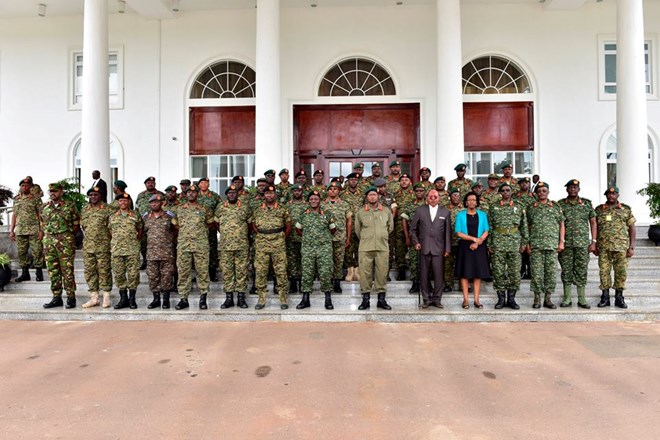
Friday May 6, 2016
By: Giles Muhame

The UPDF High Command which met on April 22 at State House Entebbe
The Uganda People’s Defence Forces (UPDF) High Command has taken what a senior official described as a “strategic decision” to put an end to the country’s armed forces’ military missions in the region, this investigative website can exclusively report.
The high-level assembly of the military’s top brass was chaired by President Yoweri Museveni, the Commander-in-Chief of the Armed Forces.
“We are getting out of Somalia and Central African Republic. It’s just a matter of time,” a highly placed senior official confided in ChimpReports on Thursday morning.
“The High Command gave instructions to military chiefs to arrange for the withdrawal of our forces in a coherent manner without jeopardising our forces’ security. This process will be carried out in phases,” the source, who preferred anonymity so as to speak freely, added.
Army Spokesperson Lt Col Paddy Ankunda was not readily available for comment when we posted this story.
On April 22, the presidency released a brief statement and pictures of the high command meeting without sharing details of what transpired.
Presidency spokesperson Lindah Nabusayi simply said the meeting “focused on National and Regional Security.”
Our sources refused to disclose what informed the historic decision, citing “security reasons.”
The High Command has the president as the chairperson; Minister of Defence, Members of the High Command on January 26, 1986; Chief of Defence Forces; Deputy CDF; Service Commanders; Chief of Staffs; Division Commanders and military experts recommended by the President among other senior officials.
The law provides that the High Command advises the President in “emergency situations and on matters relating to national security or deployment of the Defence Forces.”
The High Command also has an implementation committee of the Defence Forces responsible for supervising an implementation of its orders. This committee is usually led by the Chief of Staff.
The Entebbe meeting was attended by Chief of Defence Forces Gen Katumba Wamala, Special Forces Commander Brig Gen Muhoozi Kainerugaba, Defence Permanent Secretary Rose Byengoma, Maj Gen Phinenas Katirima, Maj Gen James Mugira, Gen Elly Tumwiine, Lt Gen Charles Angina among others.
It is understood that the removal of UPDF troops in Somalia could pose severe ramifications for regional security.
Uganda which was the first country to deploy troops under AMISOM into Somalia in March 2007 under the late Maj General, Levi Karuhanga, currently has over 6,000 soldiers and officers from the Uganda People’s Defence Force (UPDF) serving with 10,000-strong AMISOM mission, along with troops from Burundi and Djibouti.
So far, Uganda has provided all four AMISOM Force Commanders with the recent Lt. Gen. Andrew Gutti being replaced by Lt. Gen. Silas Ntigurirwa from Burundi.
Others are Maj Gen Francis Okello (March 2008 – August 2009); Maj Gen Nathan Mugisha (August 2009 – August 2011); Maj Gen Fred Mugisha (August 2011 – May 2012).
The Ugandan Contingent is currently headed by Brigadier Sam Okiding.
Consequences
With Ugandan forces being at the forefront of stabilising Somalia, the departure of the troops could plunge the country into anarchy.
The UPDF has since 2007 conducted specialised training missions for Somalis with the view that the national forces must assume the defence and security of their country.
However, even with the presence of the UPDF, Somalia continues to grapple with terror attacks in the capital Mogadishu – exposing the country’s deep security weaknesses.
It is reported that UPDF could have realised that the cost of keeping soldiers in Somalia was not only costly but a national security threat especially after the abrupt cut of the combatants’ salaries.
It will be recalled that UPDF High Command’s decision came against the backdrop of the European Union’s announcement that it would slash its support to AMISOM by 20 percent this year.
The EU covers the cost of payments to Amisom soldiers through contributions it makes to the African Union – to the tune of $200m per year.
This means Amisom soldiers receive a monthly allowance of $828 (about Shs3 million) after their respective governments deduct a $200 (about Shs700, 000) administrative cost per soldier.
Therefore, the EU cut would leave about $165 a month less in each Amisom soldier’s pocket.
Last year, it emerged that the United Nations was yet to replace UPDF choppers that crashed in Kenya as earlier promised by the international body.
In CAR, UPDF have been hunting down down LRA leader Joseph Kony and his bandits. Reports show that apart from a few raids on villages for food, the LRA organisation has lost ability to pose a security threat to Uganda.